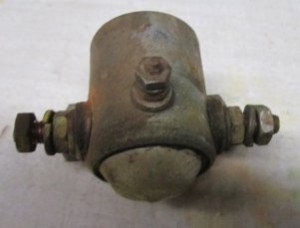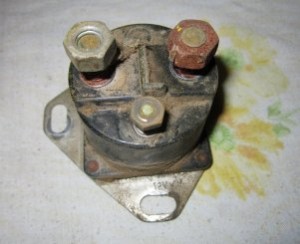If the engine doesn’t crank and the battery checks good, you have a weak or broken connection. Generally the first thing to check in this situation is the safety switch. All the narrow frame Cub Cadets with the exception of the Original, Model 70 and Model 100 came equipped with a safety switch that prevented the engine from starting unless the brake pedal was depressed.
(I have placed a jumper wire across all my safety switches. But be aware, this allows the tractor to start moving when it’s started if you leave it in gear or the hydrostat engaged. Be careful.)
The safety switch is located on the underside of the tractor and is engaged by a metal tab on the brake linkage. There is an orange wire that runs from the ignition switch to one of the safety switch terminals. There’s an orange/black wire that runs from the safety switch to the starter solenoid. The easiest check is to use your voltmeter to check the voltage at the solenoid terminal. If you place the positive lead on the solenoid terminal (it’s the smallest of the three terminals on the solenoid) and ground the negative lead you should read 12 volts when you move the key to the start position with the brake terminal depressed. The problem is that if you don’t get 12 volts, it could be a bad connection or bad ignition switch.
To isolate the problem to this section of the wiring, I generally use a jumper wire to apply voltage to the solenoid. They’ll be one large wire (usually red) that runs from the postive terminal on the battery to one terminal on the solenoid.
(The three pictures above are starter solenoids. The two pictures on the right are of the same solenoid, just different views. Notice the two large terminals and one smaller terminal on each of the solenoids. When power is supplied to the smaller terminal it makes an internal connection between the two larger terminals supplying voltage to the starter. On narrow frame Cub Cadets the starter solenoid is generally located behind the battery on the left side of the pedstal when facing towards the back of the tractor.)
Take a small jumper wire and touch one end to the terminal with the red wire and the other end to the small solenoid terminal. The engine should crank over even with the ignition key in the off position. Don’t run a jumper wire between the two large terminals unless you have a heavy wire like in jumper cables. This connection involves very high currents and would overheat a small wire and cause a fire.
If the engine cranks over with this test, you have a problem somewhere between the ignition switch and the solenoid. I would next place a jumper across the safety switch terminals. If this corrects the problem, you have a bad safety switch or corroded connections. If it doesn’t correct the problem, you probably have a bad ignition switch or corroded terminals on the ignition switch.
If the engine doesn’t crank over with the jumper across the solenoid, you may have a bad solenoid or a bad connection. I generally check this problem by using a jumper cable (again, no small wire) to jump from the positive terminal of the battery to the armature terminal of the starter/generator. If the engine doesn’t crank with this test, the starter/generator may not be properly grounded. Check this connection by running a jumper cable from the negative terminal of the battery to the frame of the starter/generator. If the engine still fails to crank, I would suspect a bad starer/generator.



